Epson ActionPrinter 4000, ActionPrinter 4500 User Manual
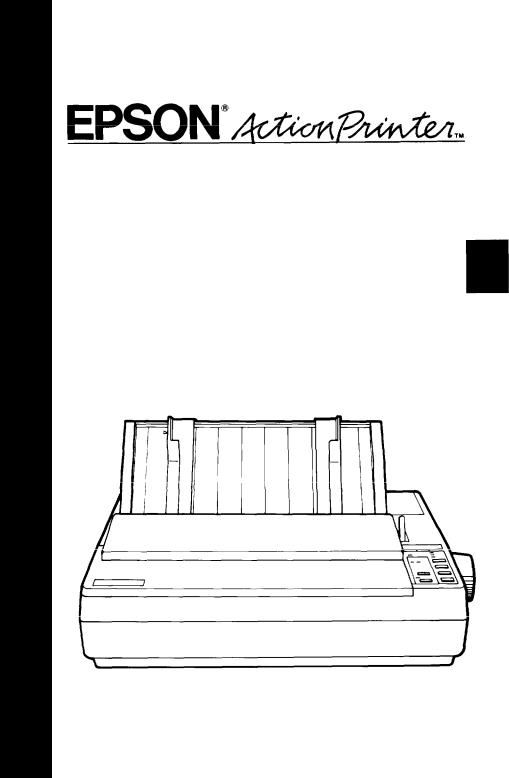
4 0 0 0 / 4 5 0 0
User’s
Manual
4000288
C01-00
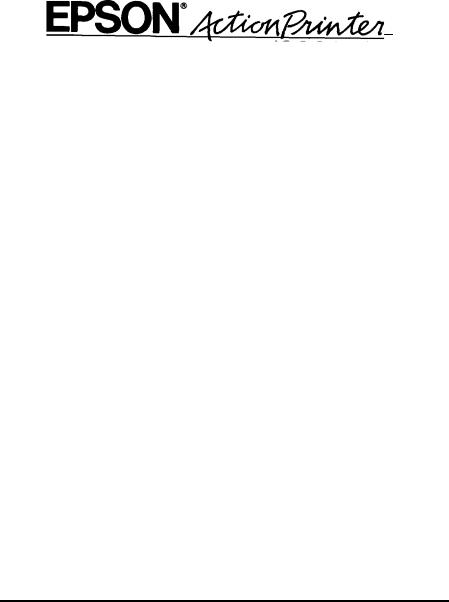
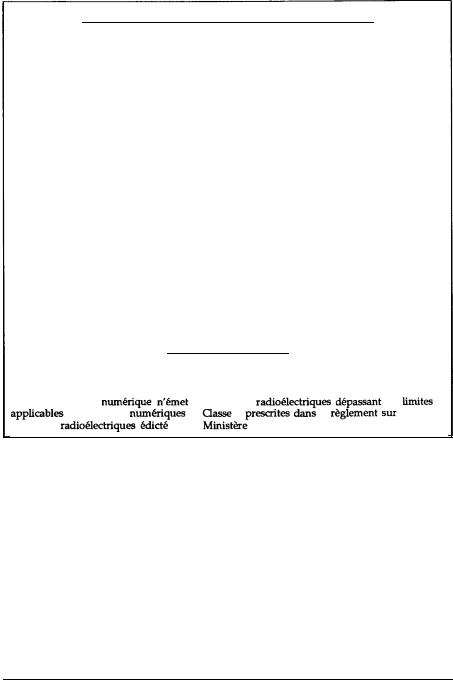

IMPORTANT SAFETY INSTRUCTIONS
1.Read all of these instructions and save them for later reference.
2.Follow all warnings and instructions marked on the product.
3.Unplug this product from the wall outlet before cleaning. Do not use liquid cleaners or aerosol cleaners. Use a damp cloth for cleaning.
4.Do not use this product near water.
5.Do not place this product on an unstable cart, stand, or table. The product may fall, causing serious damage to the product.
6.Slots and openings in the cabinet and the back or bottom are provided for ventilation; to ensure reliable operation of the product and to protect it from overheating, these openings must
not be blocked or covered. The openings should never be blocked by placing the product on a bed, sofa, rug, or other
similar surface. This product should never be placed near or over a radiator or heat register. This product should not be placed in a built-in installation unless proper ventilation is provided.
7.This product should be operated from the type of power source indicated on the marking label. If you are not sure of the type of power available, consult your dealer or local power company.
8.This product is equipped with a 3-wire grounding-type plug, a plug having a third (grounding) pin. This plug will only fit into a grounding-type power outlet. This is a safety feature. If you are unable to insert the plug into the outlet, contact your electrician to replace your obsolete outlet. Do not defeat the purpose of the grounding-type plug.
9.Do not locate this product where the cord will be walked on.
i i i

10.If an extension cord is used with this product, make sure that the total of the ampere ratings on the products plugged into the extension cord do not exceed the extension cord ampere rating. Also, make sure that the total of all products plugged into the wall outlet does not exceed 15 amperes.
11.Never push objects of any kind into this product through cabinet slots, as they may touch dangerous voltage points or short out parts that could result in a risk of fire or electric shock. Never spill liquid of any kind on the product.
12.Except as specifically explained in the User’s Manual, do not attempt to service this product yourself. Opening or removing those covers that are marked “Do Not Remove” may expose you to dangerous voltage points or other risks. Refer all servicing in those compartments to service personnel.
13.Unplug this product from the wall outlet and refer servicing to qualified service personnel under the following conditions:
A.When the power cord or plug is damaged or frayed.
B.If liquid has been spilled into the product.
C.If the product has been exposed to rain or water.
D.If the product does not operate normally when the operating instructions are followed. Adjust only those controls that are covered by the operating instructions, since improper adjustment of other controls may result in damage and will often require extensive work by a qualified technician to restore the product to normal operation.
E.If the product has been dropped or the cabinet has been damaged.
F.If the product exhibits a distinct change in performance, indicating a need for service.
iv

Contents |
|
Introduction |
1 |
Features. . . . . . . . . . . . . . . . . . . . . . . . . . . . . . . . . . . . . . . . . . . |
1 |
Options . . . . . . . . . . . . . . . . . . . . . . . . . . . . . . . . . . . . . . . . . . . |
2 |
About This Manual . . . . . . . . . . . . . . . . . . . . . . . . . . . . . . . . . |
5 |
Where to Get Help. . . . . . . . . . . . . . . . . . . . . . . . . . . . . . . . . . |
6 |
Chapter 1 Setting Up the Printer |
1-1 |
Unpacking the Printer. . . . . . . . . . . . . . . . . . . . . . . . . . . . . . . |
1-2 |
Choosing a Place for the Printer . . . . . . . . . . . . . . . . . . . . . . |
1-5 |
Assembling the Printer. . . . . . . . . . . . . . . . . . . . . . . . . . . . . . |
1-7 |
Testing the Printer. . . . . . . . . . . . . . . . . . . . . . . . . . . . . . . . . . |
1-15 |
Connecting the Printer to Your Computer . . . . . . . . . . . . . |
1-22 |
Setting Up Your Application Software . . . . . . . . . . . . . . . . |
1-25 |
Chapter 2 Paper Handling |
2-1 |
Selecting a Paper Feeding Method . . . . . . . . . . . . . . . . . . . . |
2-2 |
Using Single Sheets . . . . . . . . . . . . . . . . . . . . . . . . . . . . . . . . . |
2-4 |
Using Continuous Paper . . . . . . . . . . . . . . . . . . . . . . . . . . . . |
2-8 |
Switching Between Continuous and Single Sheets . . . . . . |
2-16 |
Printing on Special Paper. . . . . . . . . . . . . . . . . . . . . . . . . . . . |
2-23 |
Chapter 3 Using the Printer |
3-1 |
Operating the Control Panel . . . . . . . . . . . . . . . . . . . . . . . . . |
3-2 |
Selecting Typestyles . . . . . . . . . . . . . . . . . . . . . . . . . . . . . . . . |
3-6 |
Setting the DIP Switches. . . . . . . . . . . . . . . . . . . . . . . . . . . . . |
3-11 |
Page Length . . . . . . . . . . . . . . . . . . . . . . . . . . . . . . . . . . . . . . . |
3-15 |
Skip Over Perforation. . . . . . . . . . . . . . . . . . . . . . . . . . . . . . . |
3-16 |
Adjusting the Loading Position. . . . . . . . . . . . . . . . . . . . . . . |
3-17 |
Using Short Tear-off . . . . . . . . . . . . . . . . . . . . . . . . . . . . . . . . |
3-19 |
V

Selecting an International Character Set . . . . . . . . . . . . . . . |
3-22 |
|
|
Choosing a Character Set . . . . . . . . . . . . . . . . . . . . . . . . . . . . |
3-24 |
|
|
Using the Data Dump Mode . . . . . . . . . . . . . . . . . . . . . . . . . |
3-26 |
|
|
Chapter 4 Software and Graphics |
4-1 |
|
|
Enhancing Your Printing . . . . . . . . . . . . . . . . . . . . . . . . . . . . |
4-2 |
|
|
Graphics . . . . . . . . . . . . . . . . . . . . . . . . . . . . . . . . . . . . . . . . . . |
4-7 |
|
|
User-defined Characters. . . . . . . . . . . . . . . . . . . . . . . . . . . . . |
4-17 |
|
|
Chapter 5 Using the Printer Options |
5-1 |
|
|
The Cut Sheet Feeder . . . . . . . . . . . . . . . . . . . . . . . . . . . . . . . |
5-2 |
|
|
The Pull Tractor . . . . . . . . . . . . . . . . . . . . . . . . . . . . . . . . . . . . |
5-24 |
|
|
The Interface Boards . . . . . . . . . . . . . . . . . . . . . . . . . . . . . . . . |
5-37 |
|
|
Chanter 6 Maintenance |
6-1 |
|
|
Cleaning the Printer . . . . . . . . . . . . . . . . . . . . . . . . . . . . . . . . |
6-2 |
|
|
Replacing the Ribbon . . . . . . . . . . . . . . . . . . . . . . . . . . . . . . . |
6-4 |
|
|
Transporting the Printer. . . . . . . . . . . . . . . . . . . . . . . . . . . . . |
6-10 |
|
|
|
Chapter 7 Troubleshooting |
7-1 |
|
Printing . . . . . . . . . . . . . . . . . . . . . . . . . . . . . . . . . . . . . . . . . . . |
7-2 |
|
|
|
Paper Handling . . . . . . . . . . . . . . . . . . . . . . . . . . . . . . . . . . . . |
7-7 |
|
|
Options.. . . . . . . . . . . . . . . . . . . . . . . . . . . . . . . . . . . . . . . . . . |
7-10 |
|
|
Chapter 8 Technical Specifications |
8-1 |
|
|
Printer Specifications . . . . . . . . . . . . . . . . . . . . . . . . . . . . . . . |
8-2 |
|
|
Interface Specifications . . . . . . . . . . . . . . . . . . . . . . . . . . . . . . |
8-9 |
|
|
Option Specifications . . . . . . . . . . . . . . . . . . . . . . . . . . . . . . . |
8-13 |
|
|
Initialization . . . . . . . . . . . . . . . . . . . . . . . . . . . . . . . . . . . . . . . |
8-15 |
|
vi
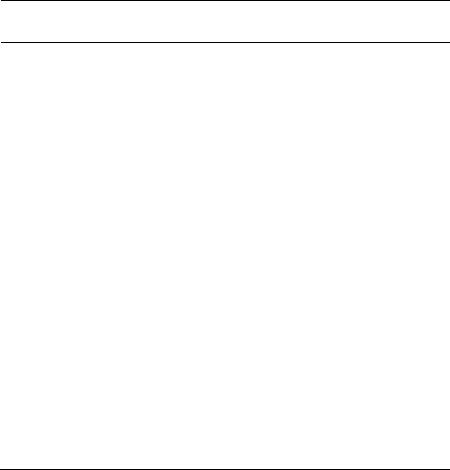
Chapter 9 Command Summary |
9-1 |
Using the Command Summary. . . . . . . . . . . . . . . . . . . . . . . |
9-2 |
Commands in Numerical Order. . . . . . . . . . . . . . . . . . . . . . |
9-5 |
Commands Arranged by Topic. . . . . . . . . . . . . . . . . . . . . . . |
9-8 |
Appendix |
A-1 |
Proportional Width Table . . . . . . . . . . . . . . . . . . . . . . . . . . . |
A-2 |
Character Sets. . . . . . . . . . . . . . . . . . . . . . . . . . . . . . . . . . . . . . |
A-6 |
Glossary
Index
vii

Introduction
The Epson® ActionPrinter 4000 and ActionPrinter 4500 are advanced 24-pin dot matrix printers combining compact design and high performance with a wide range of features.
Features
In addition to the high-quality printing and ease of operation you have come to expect from Epson printers, the ActionPrinter 4000 and ActionPrinter 4500 offer the following features:
Easy paper handling, featuring automatic single-sheet loading.
Compatibility with the Epson ESC/P® commands used by the LQ-500, LQ-510, LQ-800, LQ-850, LQ-950, LQ-1000, LQ-1010, LQ-1050, LQ-1500, LQ-2500, and LQ-2550.
Fast draft mode printing of up to 192 characters per second at 12 cpi (characters per inch).
An improved control panel design that allows direct selection of character fonts, as well as a choice of normal or condensed printing.
The SmartPark™ paper handling system, which allows use of single sheets of paper without removing the continuous paper, eliminates paper waste with short tear-off, and allows easy and accurate paper alignment.
Nine built-in Letter Quality fonts for producing high-quality documents:
Epson Roman, Epson San Serif, Epson Courier, Epson Prestige, OCR-B, OCR-A, Epson Script, Epson Orator, Epson Orator-S
A 360 x 360 dot per inch graphics mode.
Introduction 1

Introduction
•A micro-adjustment feature that allows you to feed the paper forward or backward to finely adjust the loading and short tearoff positions.
•Fifteen international character sets, an italic character set, and five graphics character sets.
•The ability to handle a wide range of paper types, including envelopes and labels.
The ActionPrinter 4000 and ActionPrinter 4500 are basically the same printer except for the width of their carriages. The ActionPrinter 4000 has a standard width carriage that accommodates paper up to a width of 10 inches. The ActionPrinter 4500 has a wide carriage that accommodates paper up to a width of 14 inches.
Throughout this manual, theActionPrinter 4000 is referred to as the standard width printer and the ActionPrinter 4500 is referred to as the wide carriage printer.
Options
A variety of printer options is available for use with your printer. For detailed information on installing and using these options, see Chapter 5.
To locate or purchase options or supplies, call Epson Accessories, Inc. at
1-800-873-7766.
•Film Ribbon Cartridge (#7768/#7770)
An optional film ribbon cartridge provides you with even higher quality printing than the standard fabric ribbon.
2 Introduction
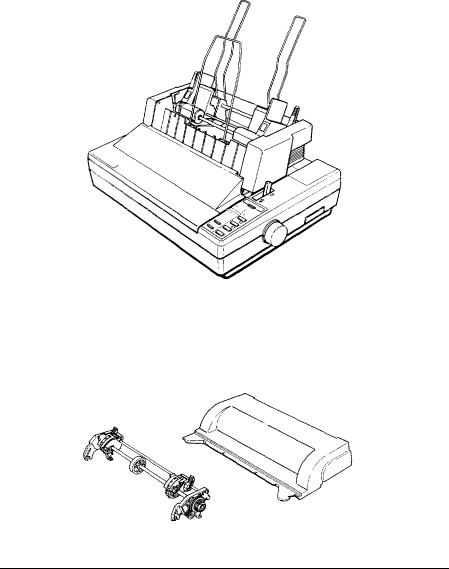
Introduction
•Single-bin Cut Sheet Feeder (C806122/806242)
The cut sheet feeder makes it possible to handle single-sheet paper more easily and more efficiently. Up to 150 sheets of standard bond paper can be automatically fed into the printer without reloading.
•Pull Tractor Unit (C800062/C800142)
This option improves the performance of continuous paper handling. It is especially useful with continuous multi-part forms.
Introduction 3
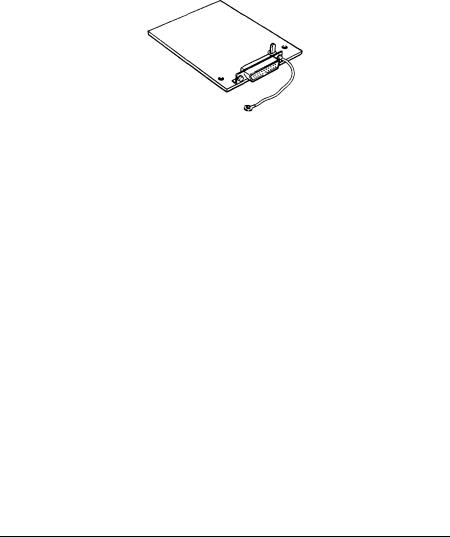
Introduction
• Interface Boards
Optional interface boards are available to supplement the printer’s built-in parallel interface. Guidelines for choosing the right interface and instructions on installing the boards are given in Chapter 5.
About This Manual
This user's manual provides fully illustrated, step-by-step instructions on setting up and operating your printer.
Finding your way around
•Chapter 1 contains information on unpacking, setting up, testing, and connecting the printer. Be sure to read and follow these instructions first. Inside the back cover of this manual are illustrations of the printer in which all of the major parts are identified.
•Chapters 2 and 3 cover paper handling and general printer operation. This important information is necessary for the day-today operation of your printer.
4 Introduction
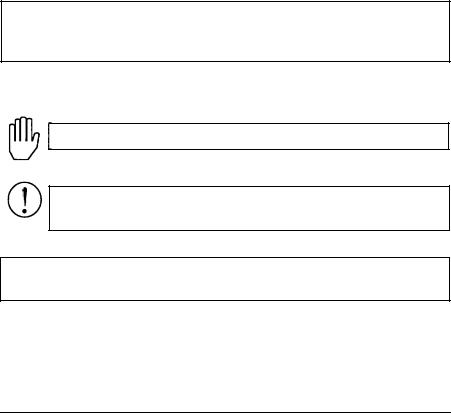

Introduction
Where to Get Help
A network of authorized Epson Customer Care Centers throughout the United States offers customer support and service for Epson products. Epson America provides product information and support to its dealers and Customer Care Centers.
Call the Epson Consumer Information Center at l-213-782-2606 for the following referrals:
•Your nearest Epson dealer
•The nearest Customer Care Center for parts and service
•Technical assistance.
6 I n t r o d u c t i o n
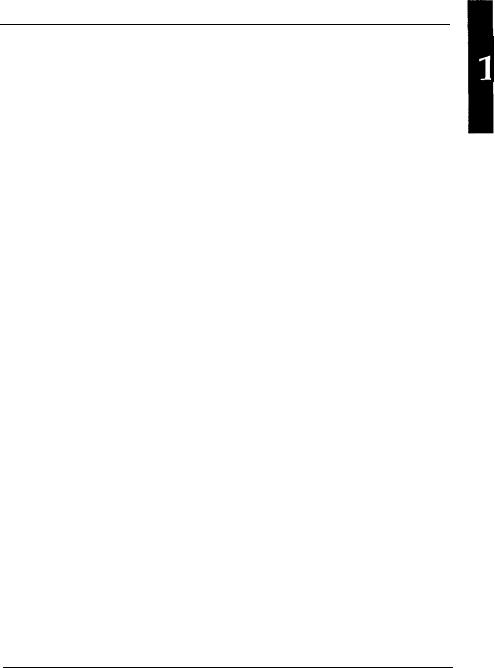
Chapter 1
Setting Up the Printer
Unpacking the Printer. . . . . . . . . . . . . . . . . . . . . . . . . . . . . . . 1-2
Checking the Parts. . . . . . . . . . . . . . . . . . . . . . . . . . . . . . . . 1-2
Removing the Protective Materials. . . . . . . . . . . . . . . . . . 1-3
Choosing a Place for the Printer . . . . . . . . . . . . . . . . . . . . . . 1-5
Assembling the Printer. . . . . . . . . . . . . . . . . . . . . . . . . . . . . . 1-7
Installing the Platen Knob . . . . . . . . . . . . . . . . . . . . . . . . . 1-7
InstaIling the Ribbon Cartridge. . . . . . . . . . . . . . . . . . . . . 1-8
Attaching the Paper Guide. . . . . . . . . . . . . . . . . . . . . . . . . 1-13
Testing the Printer. . . . . . . . . . . . . . . . . . . . . . . . . . . . . . . . . . 1-15
Plugging in the Printer . . . . . . . . . . . . . . . . . . . . . . . . . . . . 1-15
Running the Self Test . . . . . . . . . . . . . . . . . . . . . . . . . . . . . 1-15
Connecting the Printer to Your Computer . . . . . . . . . . . . . 1-22 The Parallel Interface . . . . . . . . . . . . . . . . . . . . . . . . . . . . . 1-22
Setting Up Your Application Software . . . . . . . . . . . . . . . . 1-25
Setting Up the Printer |
1-1 |
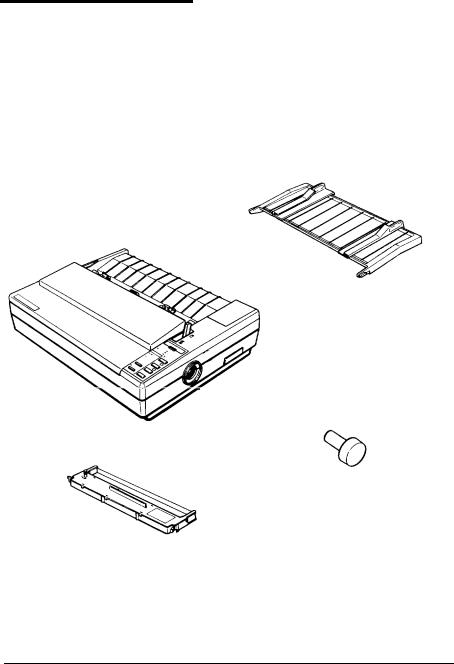
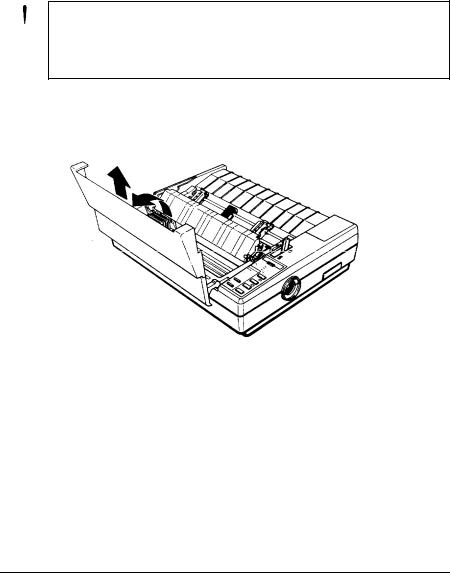
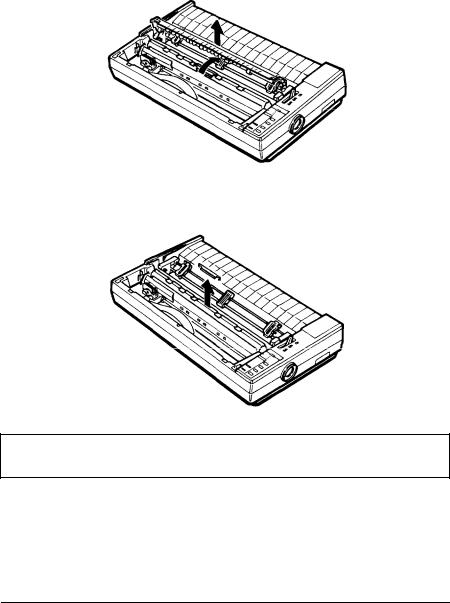
Unpacking the Printer
3.To remove the locking clip on the wide carriage printer, lift and remove the paper tension unit.
4. Remove the locking clip.
Note: Store the clip with the other packing material in case you ever need to transport your printer.
1-4 Setting Up the Printer

Choosing a Place for the Printer
There are several important things to consider when selecting a place to set up your printer. Keep the following in mind:
Place the printer on a flat, hard, stable surface. A soft surface, such as a padded counter or carpeted area, will block the ventilation slots and may cause overheating.
Place the printer close enough to the computer for the printer cable to reach.
Leave adequate room around the printer to allow for easy printer operation and maintenance, and for unrestricted flow of air around the printer.
Use a grounded outlet; do not use an adapter plug.
Avoid locations that are subject to direct sunlight, excessive heat, moisture, or dust.
Avoid electrical outlets controlled by wall switches or automatic timers. Accidental interruption of power can wipe out information in both your computer’s and printer’s memory.
Avoid using outlets that share a circuit with large motors or electrical appliances; this could cause fluctuations in line voltage.
Keep the entire computer system away from potential sources of electromagnetic interference such as loudspeakers or the base units of cordless telephones.
Setting Up the Printer |
1-5 |
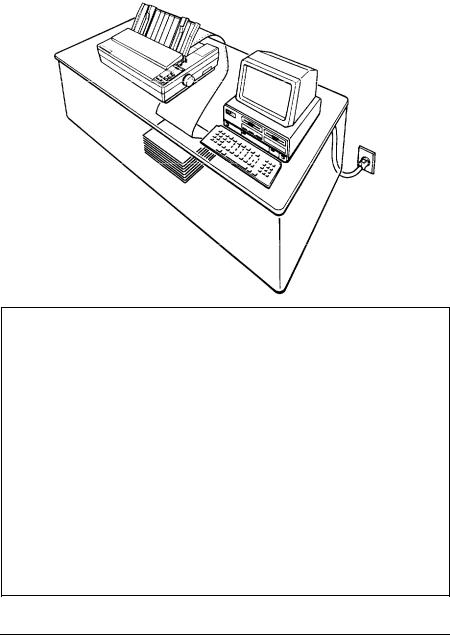
Choosing a Place for the Printer
The illustration below shows a good printer location.
Note: Before using a printer stand, read these requirements and suggestions.
•The stand should be able to support at least twice the weight of the printer.
•Never use a stand that supports the printer at an angle of more than 15 degrees from horizontal.
•With a cut sheet feeder, your printer must be kept level.
•If your paper supply is positioned below the printer stand, make sure there is enough clearance to keep the paper from catching on the underside of the stand. Also, make sure the distance between the stand supports is wide enough for the paper you are using.
•Position your printer’s cables so that they do not interfere with paper feeding. If possible, secure the cables to the printer stand.
1-6 Setting Up the Printer
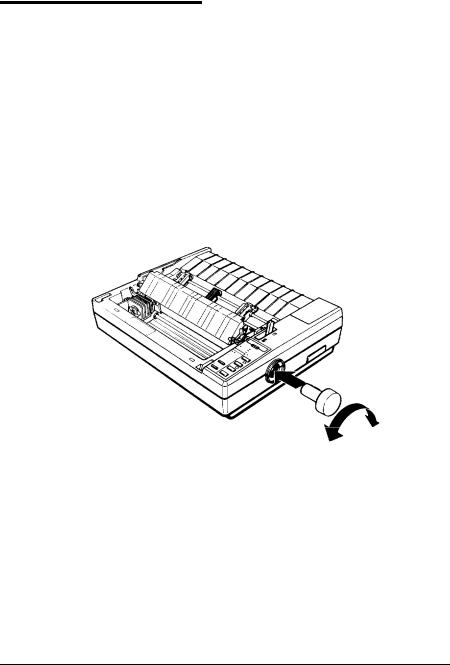
Assembling the Printer
After you’ve decided on the best place to set up your printer, the next step is to install the platen knob.
Installing the Platen Knob
The platen knob is used to feed the paper manually in the event of a paper jam or other paper feeding problem. The platen knob is packed in an indentation in the printers white foam packing material.
1.Insert the knob into the hole on the printers side and rotate it slowly until it slips onto the shaft.
Setting Up the Printer |
1-7 |

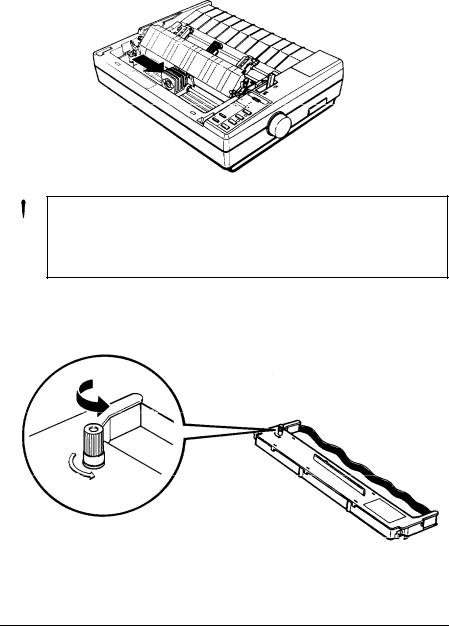
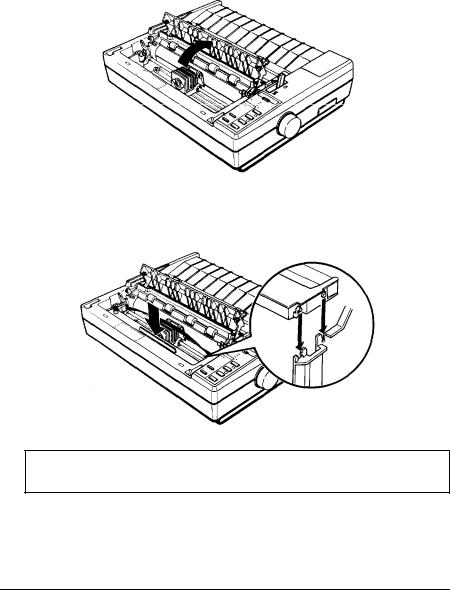
Assembling the Printer
3.On the standard width printer, open the paper tension unit cover. (On the wide carriage printer, you already removed the paper tension unit when you removed the locking clip.)
4.Hold the ribbon cartridge by its handle and push it firmly down into position, making sure the plastic hooks fit into the slots.
Note: Press lightly on both ends of the cartridge to make sure the plastic hooks are properly seated.
1-10 Setting Up the Printer
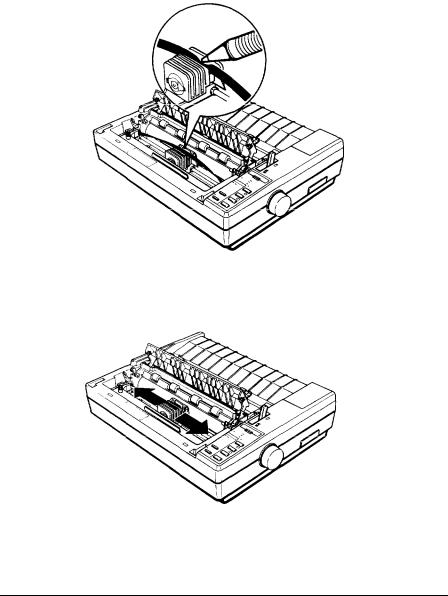
Assembling the Printer
5.Use a pointed object, such as a ball point pen, to guide the ribbon between the print head and ribbon guide while you turn the ribbon-tightening knob to help feed the ribbon into place.
6.Slide the print head from side to side to make sure it moves smoothly. Also check that the ribbon is not twisted or creased.
Setting Up the Printer |
1-11 |

Assembling the Printer
7.On the standard width printer, close the paper tension unit cover.
The standard width printer is now complete.
8.On the wide carriage printer, fit the rear notches of the paper tension unit over the pins of the printer; then lower the unit.
1-12 Setting Up the Printer
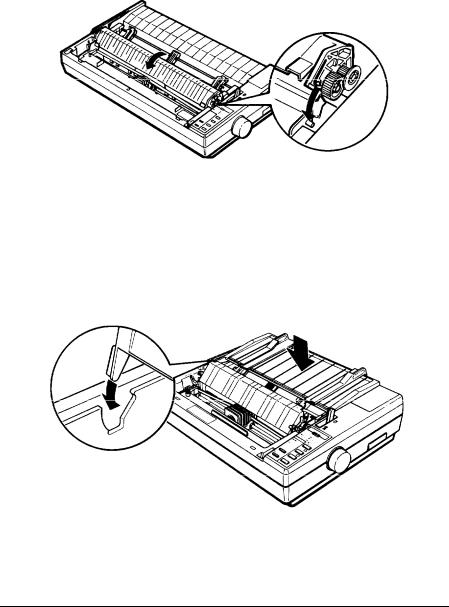
Assembling the Printer
9.Press down on both sides of the paper tension unit to lock it in place.
Attaching the Paper Guide
When you use single sheets, the paper guide helps to feed the paper smoothly and efficiently into the printer. Attach the paper guide using the following procedure.
1. Place the paper guide on the printer.
Setting Up the Printer |
1-13 |

Assembling the Printer
2. Raise the paper guide until it locks into place.
Note: To lower the paper guide, lift up slightly to release it from its locked position; then gently lower it down onto the printer.
3.Attach the printer cover by fitting the hooks on the cover into the notches at the front of the printer and tilting the cover back into place.
1-14 Setting Up the Printer
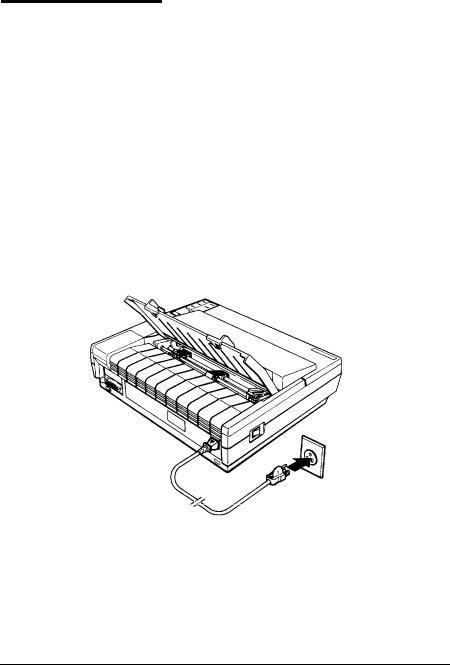
Testing the Printer
Now that your printer is fully assembled, you can use its built-in self test function to see that the printer is working correctly before you connect it to a computer. You should perform this test to make sure that your printer was not damaged during shipping and that the ribbon is correctly installed.
Before running the self test, you need to connect the printer to an electrical outlet and load a sheet of paper.
Plugging in the Printer
1.Make sure that the printer is turned off.
2.Plug the power cable into a properly grounded electrical outlet.
Running the Self Test
The self test can be run in the draft or Letter Quality mode, depending on which button you hold down as you turn on the printer.
Setting Up the Printer |
1-15 |
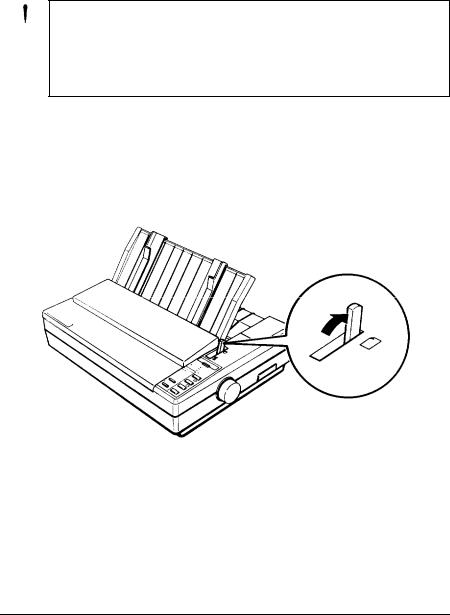
